Rifting and the passive margin
By ca. 1100 Ma, a major supercontinent--Rodinia--was assembled by collisions of different continental blocks, including ancestral North America ("Laurentia"). Several hundred million years later, in late Tonian time (ca. 760 Ma), the Rodinian supercontinent began to break up. This continental breakup led to a rifted continental margin that spanned from modern day southern California, through southeastern and central Idaho, and all the way to the Yukon. Rifting was a protracted process and was characterized by several pulses of horizontal extension and thinning of the crust.
PDF slideshows: Paleozoic rocks north of the Snake River Plain and Paleozoic rocks south of the Snake River Plain.
Neoproterozoic and Early Cambrian rifting
Rifting of Rodinia and the western margin of North America was a protracted process, with several phases of faulting and subsidence. Early rifting after ~780 Ma formed localized sedimentary basins, which are not preserved in Idaho but are preserved in the Uinta Mountains of northeastern Utah as well as in northeastern Washington. Later, widespread rifting at 720-680 Ma formed deep Neoproterozoic basins that were filled with thick sections of sedimentary rocks that are preserved in southeastern and central Idaho. Final rifting commenced at ca. 600 Ma. Neoproterozoic sedimentary rocks deposited after ~780 Ma in western North America are called the "Windermere Supergroup" (Stewart, 1972; Ross, 1991). After deposition of the Windermere Supergroup, final rifting occurred in Early Cambrian time, followed by formation of a passive continental margin by mid to Late Cambrian time.
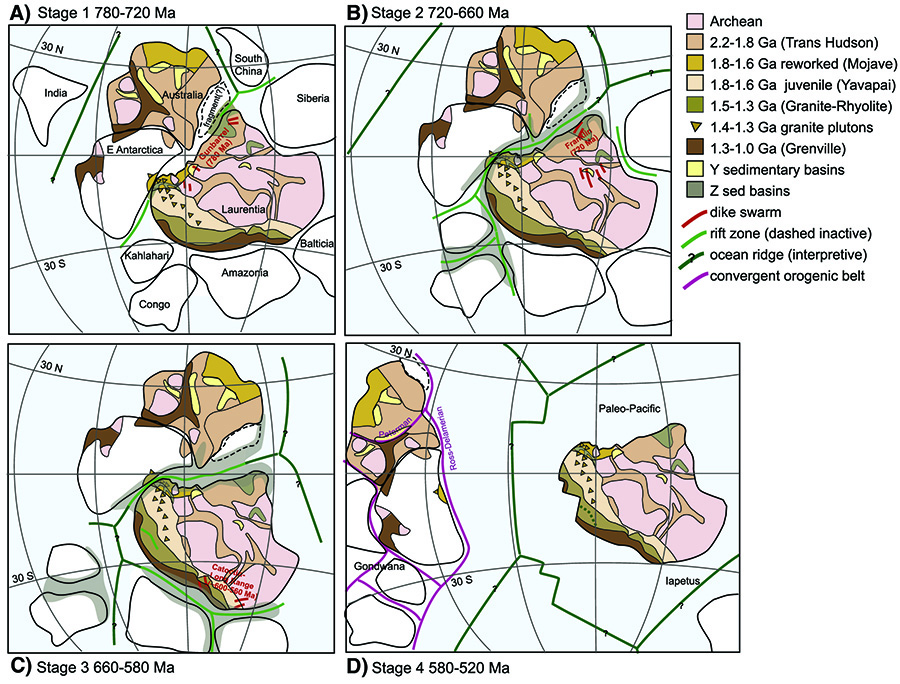
(Above) Plate reconstruction showing multiple phases of protracted Rodinian rifting. Rifting led to final separation of Australia-E Antarctica from western Laurentia. Modified from Yonkee et al. (2014).
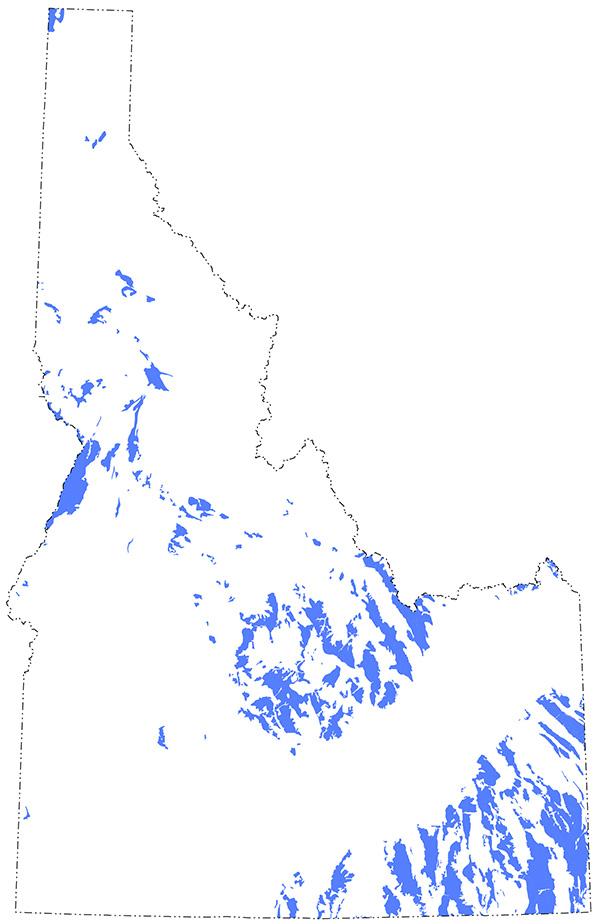
(Above) Exposures of rift- and passive margin-related rocks in Idaho
(Right) The rift and passive margin spans the entire length of western North America (modified from Brennan et al., 2022).
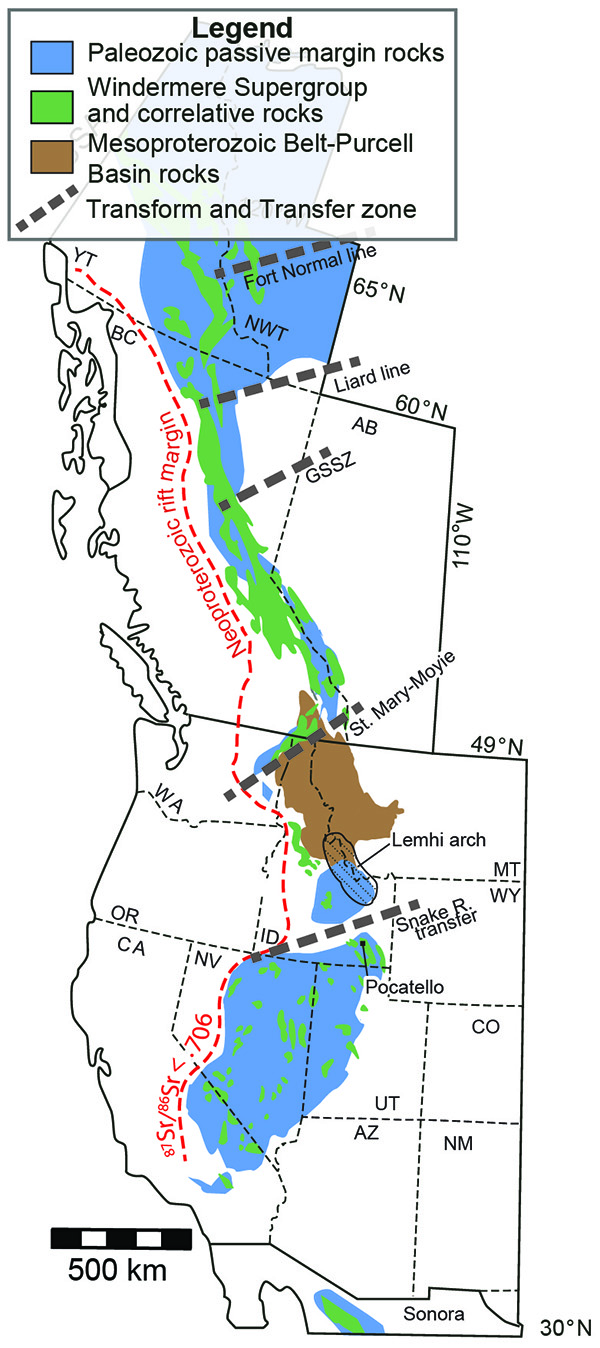
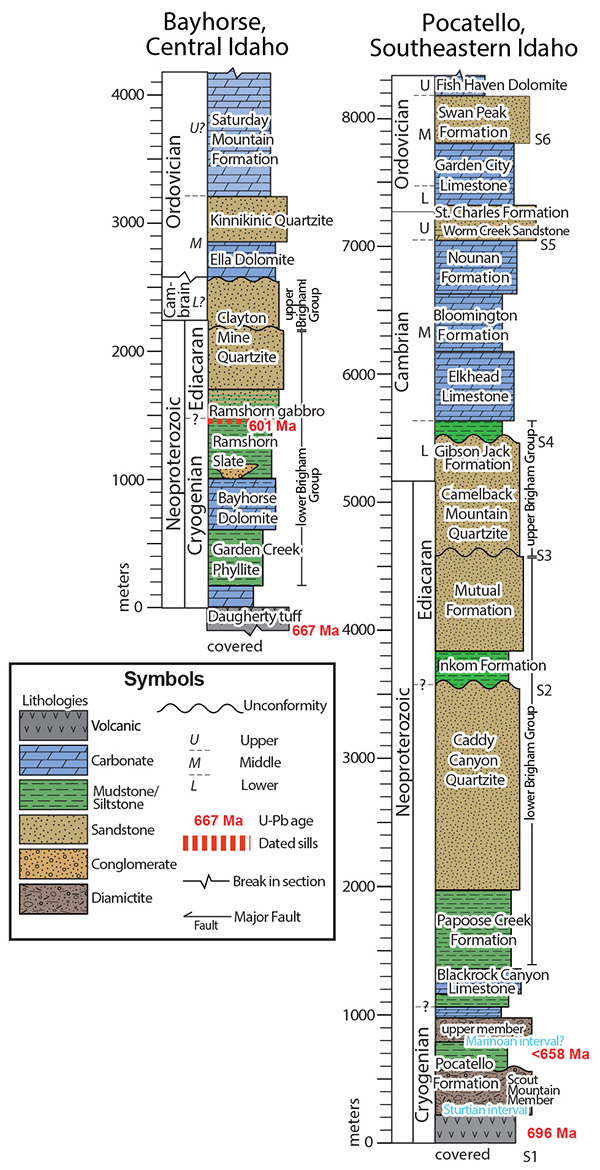
(Above) Stratigraphic columns of Neoproterozoic to Middle Ordovician sedimentary rocks deposited during rifting and early passive margin subsidence. In contrast to the thick strata in southeastern Idaho, age-correlative rocks in central Idaho are markedly thinner. Modified from Brennan et al. (2022).
Neoproterozoic rifting
The following text is revised from Link and Phoenix (1996). The oldest rocks in the southeastern Idaho thrust belt belong to the Pocatello Formation (720 to 660 million years old), which is exposed in the Bannock Range from the Pocatello area south through Oxford Mountain and almost to the Utah border. The Pocatello Formation contains two unique rock types, metamorphosed basaltic lava or greenstone, and dark-brown or gray rock known as diamictite, which contains clasts of older rocks, ranging from pebbles to boulders in size, floating in a matrix of sand and clay. Some of this diamictite was deposited as glacial-marine till during the Sturtian glaciation, one of the worldwide Neoproterozoic ice ages (Lorentz and Corsetti, 2007). Uranium-Lead (U-Pb) ages of 709 to 670 Ma are reported from the Pocatello Formation by Fanning and Link (2004).
The Brigham Group overlies the Pocatello Formation, and contains mainly sandstone or quartzite. The Brigham Group is exposed in much of the Portneuf, Bannock, and Bear River Ranges. The Wilbert Formation in the southern Beaverhead and Lemhi Ranges is correlative. The sediments which now make up the Brigham Group were deposited from about 650 to about 530 million years ago, during the time when complex life forms were developing. However, the sandstones of the Brigham Group were inhospitable places for latest Proterozoic and early Cambrian life to leave fossilized remains, and so the Brigham is largely devoid of fossils. The Brigham Group was deposited in shallow oceans and wide alluvial plains near the shorelines of those oceans.
Since the Brigham Group was deposited during Ediacaran (latest Precambrian) time, it contains records of sea-level changes during the Marinoan and Gaskiers glaciations (Levy et al., 1994), unusual excursions in the carbon-isotope compositions of sea water (Smith et al., 1994; Lorentz et al., 2004), and also could contain soft-body fossils of Ediacaran organisms. These have not yet been found, however.
Some of the micaceous quartzite or "Oakley stone" found on the flanks of the Albion Range south of Burley is probably correlative to parts of the Brigham Group. The distinctive bright green Elba Quartzite, now quarried at Park Valley, Utah, is older, of Middle Proterozoic age. It has been metamorphosed so that the chromium rich clay minerals have recrystallized to green, shiny plates of mica.
Passive margin subsidence
After Neoproterozoic and Early Cambrian rifting, the rift margin was hot. It subsequently cooled and subsided in Late Cambrian through Devonian time, forming a passive margin. When the plate margin became active, these older passive margin strata were faulted and folded in latest Devonian time by the Antler orogeny, and modified by areas of major subsidence during the Pennsylvanian to Permian Ancestral Rockies orogeny. In Late Jurassic time (<160 Ma), the passive margin rocks were progressively thrusted, folded, and intruded by continental arc magmas during the Sevier-Laramide orogeny, forming the North American Cordillera.
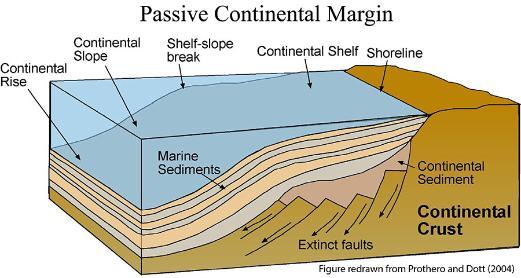
(Above) Cartoon perspective view of the geometry of a typical continental rift margin. Normal faults that accommodated rifting are overlain by passive margin strata. A similar continental rift margin was formed in western North America after ~700 Ma and is known as the Cordilleran miogeocline.
Paleozoic limestones and sandstones
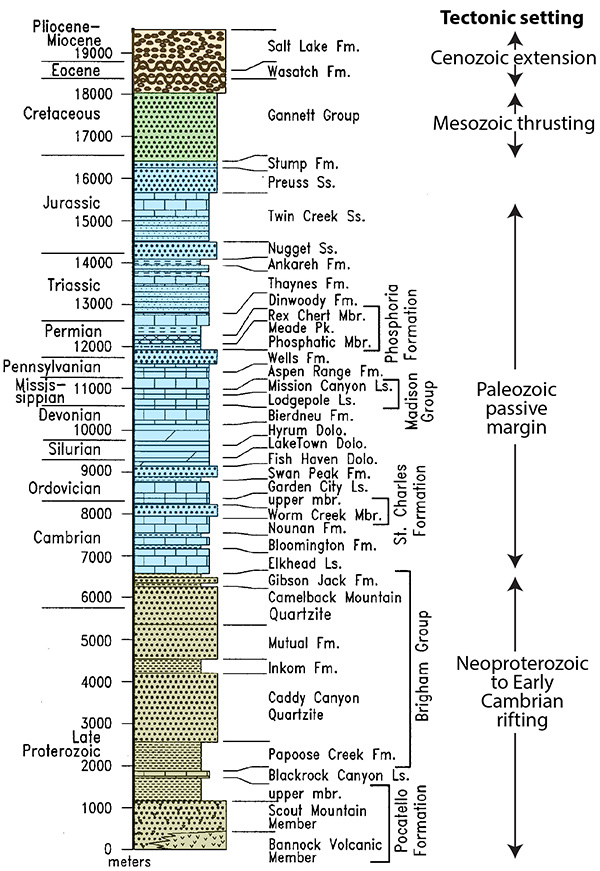
(Above) Composite stratigraphic section of southeastern Idaho and tectonic settings for different intervals in the geologic history of Idaho. Modified from Link and Phoenix (1996).
A thick sequence of carbonate rocks (limestone and dolomite), of early Paleozoic age (530 to 300 million years) lies above the Brigham Group and is present in most of the mountains of eastern Idaho. These rocks were deposited on broad carbonate platforms in warm seas off the western edge of the paleo-North American continent, settings similar to today's Bahama Banks or Great Barrier Reef. In many places, the Paleozoic limestones contain invertebrate fossils, including trilobites, bryozoans, brachiopods, corals, and molluscs, which allow determination of their age and the precise conditions under which they were deposited (Isaacson and Dorobek, 1988; Isaacson et al., 1988).
Modern surface streams are rare where most of the rocks at the Earth's surface consists of limestone. The limestone cliffs are highly porous and most of the water sinks into the subsurface. In places, extensive cavern systems exist, as at Minnetonka Cave west of St. Charles, Idaho. Large springs form where the subsurface water (groundwater) intersects the land surface. Such springs supply important parts of the municipal water supplies of southeastern Idaho. They are easily contaminated and their purity must be guarded carefully.
Thin units of fine-grained sandstones or quartzite are present within this stack of Paleozoic limestones in the Swan Peak Quartzite of Ordovician age (James and Oaks, 1977; Oaks et al., 1977) and the Wells Formation of Pennsylvanian age. These sandstones represent times when wedges of quartz sand, eroded from distant mountain ranges, prograded over the carbonate platforms.
Also present in some limestone units are gray and black chert beds and nodules, which weather to distinctive pebbles of hard flint. This chert formed from dissolved skeletons of silica-secreting invertebrates, which also existed in the warm shallow seas.
Some of the limestone has been altered to the crystalline carbonate rock dolomite. In this process original fossils are generally destroyed and the result is a light or dark gray rock that preserves bedding structures but little of the fine detail found in limestone.
Disruptions to the passive margin in central Idaho
Copper Basin Group-Antler orogeny
In southeastern Idaho, the North American plate margin remained relatively passive until late Paleozoic and early Mesozoic time. In contrast, in central Idaho, sedimentary relations were modified starting in latest Devonian time, with the Antler orogeny, and again in Pennsylvanian and Permian time, when the Wood River basin developed, in response to the Ancestral Rockies orogeny to the southeast in Colorado and new Mexico (Dickinson, 2004).
The Antler orogeny produced a thrust fault in central and northern Nevada, the Roberts Mountains thrust. This fault placed deep water, western siliceous facies continental rise strata over eastern carbonate facies carbonate rocks, and uplifted the Antler highland, which then shed sediment into a subsiding foreland basin to the east. In central Idaho, the Antler event produced the thick conglomeratic Copper Basin Group (Wilson et al., 1994; Link et al., 1996) which contains evidence of rapid subsidence, and coeval normal faulting, perhaps in an oblique normal (transtensional) structural setting (Beranek et al., 2016).
The Copper Basin Group contains up to 3 km of strata now exposed in the Pioneer Mountains between Ketchum and Mackay. Clasts in the Copper Basin Group include Ordovician quartzites of the Kinnikinic formation, and black cherts, likely sourced from the Devonian Milligen Formation from the area west of Ketchum.
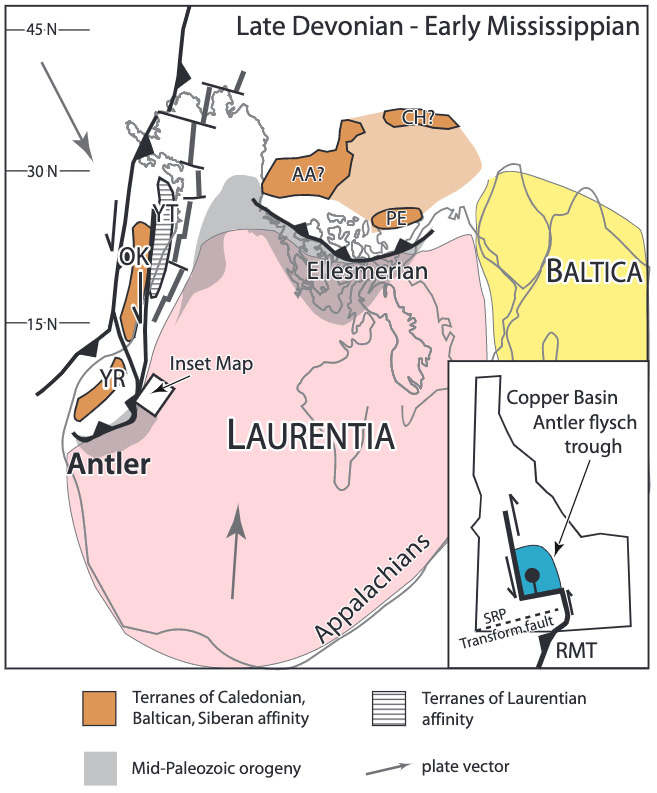
(Above) Late Devonian to Early Mississippian paleogeography and tectonic setting of the Antler orogeny in the North American Cordillera. Abbreviations: AA –Arctic Alaska; CH –Chukotka; OK –Okanagan subterrane of Quesnellia; PE –Pearya terrane; YR –Yreka subterrane of the eastern Klamath terrane (includes Trinity subterrane and Shoo Fly complex); YT-Yukon-Tanana terrane. Modified from Beranek et al. (2016). Inset map shows Copper Basin trough and Kinnikinic uplift at bends in back-arc sinistral Antler strike-slip system.
Sun Valley Group-Wood River Basin
The Milligen Formation of the Antler highland subsided in Pennsylvanian time, and the Wood River Basin formed above it. The Sun Valley Group, which contains mixed carbonate and siliciclastic rocks that underlie the Sun Valley ski area on Bald Mountain and are exposed in the Boulder and White Cloud Mountains (Mahoney et al., 1991; Link et al., 1995) was deposited into this deeply subsiding Wood River basin that was part of the larger Oquirrh Basin system of northern Utah (Geslin, 1998).
Subsidence of the Oquirrh-Wood River basin may have been controlled by interaction between compression of the Ancestral Rockies orogeny to the south and renewed uplift and isostatic loading of the Antler highland to the west.
Continue to Module 4 - Accreted Terranes
References and further reading
Beranek, L.P., Link, P.K., and Fanning, C.M., 2016, Detrital zircon record of mid-Paleozoic convergent margin activity in the northern U.S. Rocky Mountains: Implications for the Antler orogeny and early evolution of the North American Cordillera: Lithosphere, p. L557.1-18.
Brennan, D.T., Pearson, D.M., Link, P.K., and Milton, J., 2022, Neoproterozoic to early Paleozoic tectono-stratigraphic framework for central Idaho: Windermere Supergroup in the northern sector of the U.S. Cordillera, in S.J. Whitmeyer, M.L. Williams, D.A. Kellett, B. Tikoff, eds.: Laurentia: Turning Points in the Evolution of a Continent: Geological Society of America Memoir, v. 220.
Dickinson, W.R., 2004, Evolution of the North American Cordillera: Annual Review of Earth and Planetary Sciences: v. 32, p. 13-45.
Fanning, C.M., and Link, P.K., 2004, U-Pb SHRIMP ages of Neoproterozoic (Sturtian) glaciogenic Pocatello Formation, southeastern Idaho: Geology, v. 32, no. 10, p. 881-884.
Geslin, J.K., 1998, Distal Ancestral Rocky Mountains tectonism: Evolution of the Pennsylvanian-Permian Oquirrh-Wood River basin, southern Idaho: Geological Society of America Bulletin, v. 110, no 5, p. 644-663.
Isaacson, P.E., and Dorobek, S.L., 1988, Regional significance and interpretation of a coral-stromatoporoid carbonate buildup succession, Jefferson Formation (Upper Devonian), east-central Idaho, in McMillan, N.J., Embry, A.F., and Glass, D.J., eds.: Devonian of the World, Canadian Society of Petroleum Geologists, v. ii, p. 581-590.
Isaacson, P.E., McFaddan, M.D., Measures, E.A., and Dorobek, S.L., 1988, Coral-stromatoporoid carbonate buildup succession, Jefferson Formation (Late Devonian), central Idaho: U.S.A., in Geldsetzer, H.H.J, James, N.P., and Tebbutt, G.E., eds., Reefs: Canada and adjacent area: Canadian Society of Petroleum Geologists Memoir 13, p. 471-477.
James, W.C., and Oaks, R.Q., Jr., 1977, Petrology of the Kinnikinic Quartzite (Middle Ordovician), east-central Idaho: Journal of Sedimentary Petrology, v. 47, p. 1491-1511.
Levy, M, Christie-Blick, N., and Link, P.K., 1994, Neoproterozoic incised valleys of the eastern Great Basin, Utah and Idaho: Fluvial response to changes in depositional base level: in Dalrymple, R.W., Boyd, R., and Zaitlin, B.A., editors, Incised Valley Systems: Origin and Sedimentary Sequences, Tulsa, OK., SEPM (Society for Sedimentary Geology) Special Publication 51, p. 369-382.
Link, P. K., and Phoenix, E. C., 1996, Rocks, Rails, and Trails: Idaho Museum of Natural History, Pocatello, 194 p.
Link, P.K., Mahoney, J.B., Batatian, L.D., Bruner, D.J., and Williams, F., 1995, Stratigraphic setting of sediment-hosted mineral deposits in the eastern part of the Hailey 1° x 2° quadrangle, and part of the southern part of the Challis 1° x 2° quadrangle, South-Central Idaho: U.S. Geological Survey Bulletin 2064-C, p. C1-C33.
Link, P.K., Warren, Ian, Preacher, J.M., and Skipp, Betty, 1996, Stratigraphic analysis and interpretation of the Copper Basin Group, McGowan Creek Formation and White Knob Limestone, south-central Idaho: in Longman, M. W. and Sonnenfeld, M. D eds., Paleozoic Systems of the Rocky Mountain Region, Rocky Mountain Section, SEPM (Society for Sedimentary Geology), p. 117-144.
Mahoney, J.B., Link, P.K., Burton, B.R., Geslin, J.K., and O’Brien, J.P., 1991, Pennsylvanian and Permian Sun Valley Group: Wood River basin, south-central Idaho, in Cooper, J.D., and Stevens, C.H., eds., Paleozoic paleogeography of the western United States – II: Pacific Section, SEPM (Society for Sedimentary Geology), v. 67, p. 551-580.
Oaks, R.J., Jr., James, W.C., Francis. G.G., and Schulingkamp, W.J., II, 1977, Summary of Middle Ordovician stratigraphy and tectonics, northern Utah, southern and central, Idaho, Wyoming Geological Association Guidebook: 29th Annual Field Conference, p. 101-118.
Ross, G.M., 1991, Tectonic setting of the Windermere Supergroup revisited: Geology, v. 19, p. 1125–1128.
Smith, L.H., Kaufman, A.J., Knoll, A.H., and Link, P.K., 1994, Chemostratigraphy of predominantly siliciclastic Neoproterozoic successions: a case study of the Pocatello Formation and Lower Brigham Group, Idaho, USA: Geological Magazine, v. 131, no. 3, p. 301-314.
Stewart, J.H., 1972, Initial Deposits in the Cordilleran Geosyncline: Evidence of a Late Precambrian (<850 m.y.) Continental Separation: Geological Society of America Bulletin, v. 83, p. 1345–1360.
Wilson, E., Preacher, J.M., and Link, P.K., 1994, New constraints on the nature of the Early Mississippian Antler sedimentary basin in Idaho: in Embry, A.F., Beauchamps, B. and , Glass, D.J., eds., Pangea: Global Environments and Resources: Canadian Society of Petroleum Geologists Memoir 17, p. 155-174.
Yonkee, W.A., Dehler, C.D., Link, P.K., Balgord, E.A., Keeley, J.A., Hayes, D.S., Wells, M.L., Fanning, C.M., and Johnston, S.M., 2014, Tectono-stratigraphic framework of Neoproterozoic to Cambrian strata, west-central U.S.: Protracted rifting, glaciation, and evolution of the North American Cordilleran margin: Earth-Science Reviews, v. 136, p. 59–95.
Credits
This page was originally created by Paul Link and Laura DeGrey-Ellis; it was modified and updated by Dave Pearson at Idaho State University.
